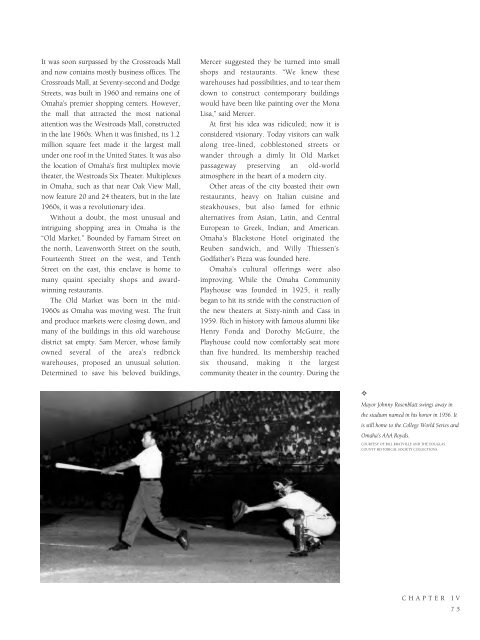Historic Omaha
An illustrated history of Omaha and the Douglas County area, paired with the histories of companies, families and organizations that make the region great.
An illustrated history of Omaha and the Douglas County area, paired with the histories of companies, families and organizations that make the region great.
Create successful ePaper yourself
Turn your PDF publications into a flip-book with our unique Google optimized e-Paper software.
It was soon surpassed by the Crossroads Mall<br />
and now contains mostly business offices. The<br />
Crossroads Mall, at Seventy-second and Dodge<br />
Streets, was built in 1960 and remains one of<br />
<strong>Omaha</strong>’s premier shopping centers. However,<br />
the mall that attracted the most national<br />
attention was the Westroads Mall, constructed<br />
in the late 1960s. When it was finished, its 1.2<br />
million square feet made it the largest mall<br />
under one roof in the United States. It was also<br />
the location of <strong>Omaha</strong>’s first multiplex movie<br />
theater, the Westroads Six Theater. Multiplexes<br />
in <strong>Omaha</strong>, such as that near Oak View Mall,<br />
now feature 20 and 24 theaters, but in the late<br />
1960s, it was a revolutionary idea.<br />
Without a doubt, the most unusual and<br />
intriguing shopping area in <strong>Omaha</strong> is the<br />
“Old Market.” Bounded by Farnam Street on<br />
the north, Leavenworth Street on the south,<br />
Fourteenth Street on the west, and Tenth<br />
Street on the east, this enclave is home to<br />
many quaint specialty shops and awardwinning<br />
restaurants.<br />
The Old Market was born in the mid-<br />
1960s as <strong>Omaha</strong> was moving west. The fruit<br />
and produce markets were closing down, and<br />
many of the buildings in this old warehouse<br />
district sat empty. Sam Mercer, whose family<br />
owned several of the area’s redbrick<br />
warehouses, proposed an unusual solution.<br />
Determined to save his beloved buildings,<br />
Mercer suggested they be turned into small<br />
shops and restaurants. “We knew these<br />
warehouses had possibilities, and to tear them<br />
down to construct contemporary buildings<br />
would have been like painting over the Mona<br />
Lisa,” said Mercer.<br />
At first his idea was ridiculed; now it is<br />
considered visionary. Today visitors can walk<br />
along tree-lined, cobblestoned streets or<br />
wander through a dimly lit Old Market<br />
passageway preserving an old-world<br />
atmosphere in the heart of a modern city.<br />
Other areas of the city boasted their own<br />
restaurants, heavy on Italian cuisine and<br />
steakhouses, but also famed for ethnic<br />
alternatives from Asian, Latin, and Central<br />
European to Greek, Indian, and American.<br />
<strong>Omaha</strong>’s Blackstone Hotel originated the<br />
Reuben sandwich, and Willy Thiessen’s<br />
Godfather’s Pizza was founded here.<br />
<strong>Omaha</strong>’s cultural offerings were also<br />
improving. While the <strong>Omaha</strong> Community<br />
Playhouse was founded in 1925, it really<br />
began to hit its stride with the construction of<br />
the new theaters at Sixty-ninth and Cass in<br />
1959. Rich in history with famous alumni like<br />
Henry Fonda and Dorothy McGuire, the<br />
Playhouse could now comfortably seat more<br />
than five hundred. Its membership reached<br />
six thousand, making it the largest<br />
community theater in the country. During the<br />
✧<br />
Mayor Johnny Rosenblatt swings away in<br />
the stadium named in his honor in 1956. It<br />
is still home to the College World Series and<br />
<strong>Omaha</strong>’s AAA Royals.<br />
COURTESY OF BILL KRATVILLE AND THE DOUGLAS<br />
COUNTY HISTORICAL SOCIETY COLLECTIONS.<br />
CHAPTER IV<br />
75
















